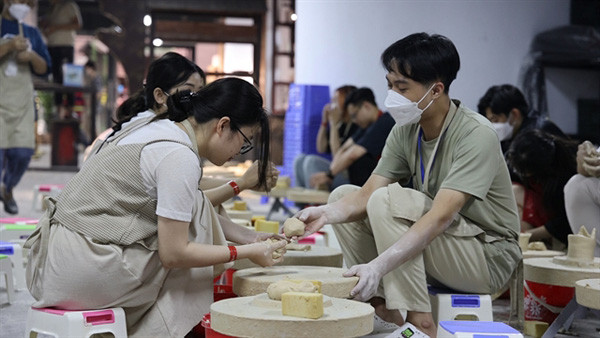Located 20 kilometres away from downtown Hanoi, the museum has become a popular destination for people who want a glimpse of the traditional crafts of Vietnam.

The museum consists of seven potter's wheel-shaped buildings linked together with their outer walls curved into multi-layered patterns.
“The design takes inspiration from a potter's wheel, an indispensable tool that ceramic artists cannot live without," Bui Van Tu of the Vietnamese cultural craft village centre said.
“Visitors can have a fantastic experience in the museum. Coming here, they can make clay pots on a potter's wheel or enjoy shadow sculptures. They also have the chance to learn how craftsmen make ceramic products and can visit booths displaying potteries and other items from Hanoi’s craft villages. This museum brings young people closer to pottery.”

The museum is in Bat Trang Village, one of the most famous traditional ceramic villages in northern Vietnam. Its appearance helps attract more visitors, especially young people.
Ha Thuy Huong, a student from the Hanoi University of Commerce, learnt about the museum through TikTok and often visits with friends.
“This is a unique design. It’s like it is made out of pottery, not cement. The colour looks good and there is ample space," Huong said.
“The pottery village had very few activities for visitors, mostly sightseeing and making pottery. It was more suitable for the older generation. But here in this space, I am surrounded by young people. More people will know about ceramic art through this museum.”

This five-storey museum displayed artistic ceramic products on the second and third floors. Through the products, visitors can learn about the formation and development of Bat Trang Pottery Village.
The many types of ceramic glazes, from ancient to modern and the changes in colour, shape and decorative motifs are also introduced to visitors.
On the first floor, visitors can make their own pottery products. Meanwhile, the outer space on the fourth and fifth floors is for cafes, restaurants, and shadow sculpture exhibitions.

Many grade schools choose the museum as an extracurricular activity.
Nguyen Nhu Hoang Nhan, a 12th grader, could not hide his excitement when visiting.
“I am very excited. I wanted to visit this place before. Today my school has an outing, and we are coming here. We learn about pottery and have the chance to work on our own potteries. Making clay products is quite challenging for us,” he said.
The museum expects to welcome more tourists as the border has reopened for tourism. It aims to help preserve and introduce the signature cultural values of Bat Trang ceramic village to visitors.
“As Vietnam has reopened tourism, we hope to welcome both domestic and international visitors coming to Bat Trang to get a glimpse of the pottery craft and learn more about Vietnamese culture,” cultural expert Tu said.
Source: Vietnam News